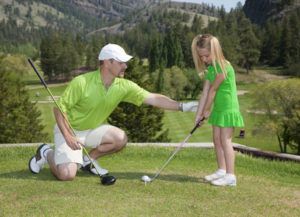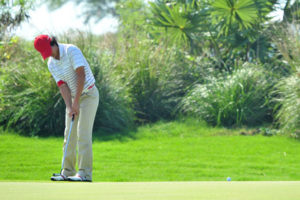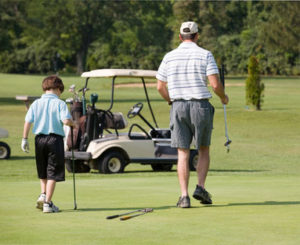Golf is an excellent form of exercise that provides many additional benefits for kids of all ages. In addition to enjoying the outdoors, your child can gain skills surrounding the management of emotions, self-control, and the development of lasting friendships.
Although golf is considered an incredibly safe sport, there is always a possibility that accidents, injuries, or trauma could occur. By following the tips listed below, you’ll be able to lower your risk of these incidents and enjoy all the benefits that golf has to offer.

Weather-Related Safety Tips
Knowing how to deal with unpredictable weather is vital in the game of golf. Although the weather can change at the drop of a hat, being prepared for these changes can help you remain safe. Consider the following weather elements and tips for handling them appropriately.
* Sun Exposure
Since you’ll be outdoors for long periods of time, you will want to protect your skin from the sun. A proper sunscreen, visor, and light-colored protective clothing is recommended.
* Lightning
During certain times of the year, thunderstorms can seem to pop up at a moment’s notice. Since you’ll be carrying around a metal rod, lightning presents a true danger to those on the course. If a thunderstorm occurs while you’re playing golf, you should put your club away and seek proper shelter until the storm passes. Never take a chance on continuing to play when lightning is present.
* Wind and Chill
Safety glasses and a windproof umbrella, paired with the proper attire, can provide a great deal of protection from harsh winds and colder temperatures. Wind can make it difficult to see properly, so the correct gear can keep you safe and improve your game.
Golf Cart Safety Tips
People may not give a lot of thought to operating a golf cart in a safe manner. After all, they aren’t being driven on a busy highway. However, accidents and injuries do often occur as a result of driving a golf cart recklessly.
First and foremost, a golf cart should only be driven by someone who is licensed and experienced in handling its basic operations. Adolescents are sometimes qualified to properly handle a golf cart, especially if an adult is present to oversee things. Basic rules such as remaining on the proper golf cart path, avoiding driving over rough terrain, and keeping extremities inside the cart at all times can drastically cut down on the risk of injuries.
What Happens When Someone Yells “Fore”?
Another common injury that can occur on the golf course involves being hit by a stray ball. While it’s not common, potentially serious or even fatal injuries can occur from a golf ball striking an individual. For this reason, it’s imperative that a golfer pays attention to his surroundings constantly. Never take a swing if there’s a possibility that your ball could end up hitting someone. Rather, wait until the coast is clear before swinging.
It’s possible that someone may inadvertently step in the way of your ball after you’ve made your swing. Perhaps they went unnoticed because they were behind a tree or bush. It’s important to always yell “fore” if this occurs. This will allow other players and individuals on the course to be aware that a golf ball may be headed in their direction.
On a similar note, if you’re playing golf and another player yells “fore”, don’t look for the ball or you risk being hit directly in the face or head. Rather, take cover behind a tree or inside your golf cart if it is nearby. If there are no objects to use to protect yourself, you can always shield your face and head with your arms.
Swinging Safety Tips
As stated earlier, golf is considered a very safe sport. Most golf injuries are repetitive use injuries, meaning they occur due to making frequent motions in a similar fashion repeatedly. Conditions such as bursitis, tendonitis, and pain in the back or joints are common repetitive use injuries that can occur in the sport of golf. Using a proper technique each and every time you swing your club can reduce the chances of suffering from one of these injuries. For example, back pain most often occurs as a result of an incorrect stance when swinging.
Keeping Yourself and Others Safe
In addition to repetitive use injuries, swinging a golf club can injure others too. If someone is standing too close to you when you swing, they could be accidentally hit by your club. Always be aware of your surroundings and ensure that others remain a safe distance from you as you take your swing. It also important to remember that you are responsible for your own safety on the course. Take steps to protect yourself from being hit by someone else’s club by remaining a safe distance away when they swing. Don’t assume that they’re watching out for you and will let you know if you’re in the way.
Proper Attire and Gear Helps Performance and Comfort
Wearing the proper clothing and shoes can go a long way toward keeping you safe, comfortable, and successful on the course. Light-colored clothing reflects the sun away from you, helping you remain cool on hot days. Many players also use appropriate umbrellas, glasses, and other accessories to help block dangerous winds and chill that can affect the player’s comfort and safety.
As with any physical activity, it’s also important to practice a safe warm-up prior to the start of the game. Taking a brisk walk or engaging in some basic stretching exercises can help warm up your muscles prior to playing, thus reducing the risk of injuries and pain.
Golf remains a popular sport for children and adults of all ages. Golf is engaging, fun, and allows children to develop important skills that can benefit them in many areas of life. Lastly, golf is also a very safe sport. By following the tips outlined here, your child can enjoy the advantages golf has to offer in a safe, healthy, and productive manner.
 Young children who are enrolled in a golf academy for kids at an early age learn to have confidence in their abilities. Youngsters enjoy comparing their previous attempts at playing golf to their current, improved undertakings. From learning new skills to attaining their goals, kids develop greater self-assurance.
Young children who are enrolled in a golf academy for kids at an early age learn to have confidence in their abilities. Youngsters enjoy comparing their previous attempts at playing golf to their current, improved undertakings. From learning new skills to attaining their goals, kids develop greater self-assurance.



 The winter is a great time to get together with family and spend time together. However, every parent knows how hard it can be to manage the winter with children. During the summer, kids like to play outside. During the winter, on the other hand, children often have to spend more time inside. This resulting cabin fever is a problem for kids and adults alike. We believe that this problem can be easily addressed with a quality after-school sports kids winter program.
The winter is a great time to get together with family and spend time together. However, every parent knows how hard it can be to manage the winter with children. During the summer, kids like to play outside. During the winter, on the other hand, children often have to spend more time inside. This resulting cabin fever is a problem for kids and adults alike. We believe that this problem can be easily addressed with a quality after-school sports kids winter program.




 As any golfer knows, choosing the right clubs makes a big difference when it comes time to play. This is especially true for kids. Young players need clubs of the right size and weight for their needs. Equipment that is ill-fitted can create bad habits and swing problems that can be difficult to unlearn later. Children may also get frustrated with the difficulty of the game or their results and not want to keep playing due to ill-fitted equipment.
As any golfer knows, choosing the right clubs makes a big difference when it comes time to play. This is especially true for kids. Young players need clubs of the right size and weight for their needs. Equipment that is ill-fitted can create bad habits and swing problems that can be difficult to unlearn later. Children may also get frustrated with the difficulty of the game or their results and not want to keep playing due to ill-fitted equipment. Golfing can be a great family pastime and wonderful sport for kids, but you’ll need to be sure that your children understand more than just the rules of the game. Etiquette is very important at the course, and you’ll want to take the time to ensure that your children are well-behaved before you start teaching the secrets of a good swing.
Golfing can be a great family pastime and wonderful sport for kids, but you’ll need to be sure that your children understand more than just the rules of the game. Etiquette is very important at the course, and you’ll want to take the time to ensure that your children are well-behaved before you start teaching the secrets of a good swing.


 Our 11,000 square-foot Buckhead Academy has been specifically designed to allow all facets of the game to be practiced in a safe and friendly setting.
Our 11,000 square-foot Buckhead Academy has been specifically designed to allow all facets of the game to be practiced in a safe and friendly setting.